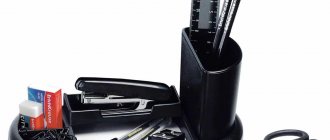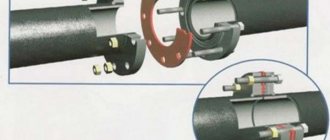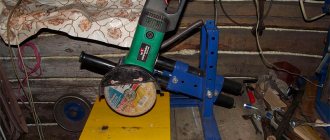A hand saw, despite the variety of electric tools, still remains one of the most popular devices when working with wood.
It is characterized by its low cost, compactness and immediate readiness for use. The use of a hacksaw is especially important when there is no source of electricity.
In order for sawing to be done quickly and correctly, you need to know how to sharpen a hacksaw on wood at home if you don’t have a sharpening machine or a grinder.
How to sharpen a hacksaw yourself
A hacksaw for wood is one of the “eternal” values.
But, in order for a hand saw to always perform its functions, it must be sharpened correctly.
This is where basic knowledge about the type of cutting edge and its features will come in handy.
Of the existing methods, we will consider the safest and most popular ones, using available tools and available for home use.
Why sharpen and when?
With constant use, the teeth lose their sharpness, the cutting edges wear out, deteriorating the quality of the cut and increasing the time it takes to complete the task.
Buying a new one will not correct the situation for long, and it will take no more than half an hour to restore the old canvas.
Timely sharpening of the hacksaw will restore the cutting ability of the incisors, and will always allow you to have a working tool at hand.
It is worth correcting the sharpness of the cutting edges at the first signs of wear, which can affect local areas and the entire working surface.
The dimensions of the cutter set also change, and this leads to jamming during operation.
How to determine when it’s time to sharpen a hacksaw?
How to determine when it's time to sharpen the teeth of the tool.
An experienced owner knows when and how to sharpen a hacksaw, but it is not difficult for the average person to determine this point on their own. As a rule, the sound produced during operation and the uniformity of the color of the cutting edge change.
Sharp cutters are characterized by uniform wear of the cutting edge.
The following signs indicate the need to “correct” the saw:
• sawing is difficult and uneven; • the cut is uneven; • the blade often gets stuck; • it becomes difficult to maintain a given trajectory.
In addition, a dull hacksaw often gets stuck and requires a lot of effort to complete the process.
Alignment of teeth
During operation, the teeth of a hacksaw can not only deviate from the correct geometry, but also become completely deformed in height. Curvatures also need to be restored, but strictly after sharpening and setting. And again the question arises - how to sharpen a hacksaw correctly so that the result is straight teeth? During this procedure, you can only reduce the likelihood of aggravating the situation with the same file. To do this, the pressure when sharpening should be moderate and directed strictly at the edges and edges. And at the end of the hacksaw maintenance process, a separate leveling procedure follows, which is performed with pliers or a vice by firmly gripping the problem teeth.
How to sharpen a hacksaw with your own hands
How to sharpen a hacksaw yourself if the need arises?
First you need to decide what material the work cloth is made of.
Ordinary steel can be corrected independently, but teeth with pobeditovy tips can only be processed on specialized industrial machines.
Some craftsmen, at their own peril and risk, undertake to sharpen a hacksaw using a grinder - but this is an unreliable and dangerous method.
To tidy up an ordinary manual hacksaw for wood at home, you will need to determine the shape of the teeth, prepare everything you need, and be sure to follow safety precautions.
General saw sharpening technology
The hacksaw is fixed in the prepared clamp in the most convenient position for work, after which you can begin work in accordance with the following rules:
- The handle of the file should be held with your right hand, and its end should be held with your left. The tool must be directed towards the teeth.
- Returning the file to its original position should not be accompanied by an abrasive effect on the teeth. That is, the correction is performed only in the “away” direction. As for the pressure, it should be soft, smooth and, most importantly, uniform.
- The main problem that many people face when sharpening cutting and piercing tools on their own is the different degrees of sharpening in different areas. How to sharpen a hacksaw at home to ensure equal correction of all teeth? As already noted, one should strive for uniformity, but this is not enough. It is important that each tooth receives approximately the same number of passes with the same direction angle and file height.
General requirements for sharpening
Not every garage or workshop has a special machine for sharpening hacksaws, but it won’t hurt to sharpen the tool yourself.
There are, of course, exceptions - hardened teeth cannot be sharpened.
Diamond drills and other tricks will not help.
This saw has an increased service life and must not be repaired, but replaced with a new one.
It is easy to identify hardened steel - it is distinguished by its black color with a blue tint.
A grinder or a file and a needle file are usually used as a sharpener for a hacksaw.
A prerequisite is to first carry out the correct setting of the teeth, because the thickness of the hacksaw blade affects the width of the cut, so the edges must be bent to the required width.
Features of sharpening cross saws
To maintain the crosscut saw, a triangular file is used. It should have a fine notch with a 60-degree angle at the top. The angle of the hacksaw in the clamping device should be 45-50°. The file is held parallel to the table at an angle of 70-75° relative to the saw blade. The most important difference in working with cross-cut saws will be maintaining a special sequence in terms of processing the teeth. How to sharpen a hacksaw without disturbing the correct configuration of the cutting row? The teeth are sharpened in several approaches. The first technique concerns only odd teeth, and only the left edges are corrected. Next, the right edges of the same teeth are processed. Then the blade is turned over and the even teeth are sharpened in the same sequence, starting from the far row.
Necessary tool
Sharpening a hacksaw using a grinder or grinder requires certain skills.
It is much safer and easier to sharpen a hacksaw mechanically.
Before you begin, prepare a vice or clamp, calipers, hammer and other necessary tools:
Crosscut saws are sharpened at an angle of 60 degrees using a triangular fine file.
Longitudinal with an angle of less than 60 degrees - use a large needle file or diamond file with fine abrasive.
For a mixed type, you will need a coarsely cut file or a finely cut diamond file.
For this operation, a special sharpening device is useful - a wooden block with a cut-out socket to protect your hands from cuts.
NOTE:
To sharpen a hacksaw using a grinder, you will need a cutting wheel with a thickness of 1.2 to 1.4 mm, with a diameter of 115 or 125 mm. The angle grinder must have a speed adjustment in the range of 5000 - 8000 per minute. Installing protection is a prerequisite for using this method. As a rule, a homemade shield made of transparent plastic is used.
Wood saw sharpening technology
Proper sharpening of a hacksaw should preserve the working profile of the teeth.
It is determined by the following parameters:
• pitch and height; • point angle; • radius of curvature.
The sharpening angle can be set in the range from 30 to 60 degrees, and depends on the material.
So, for soft wood, 50 degrees will be optimal.
It is important to secure the blade correctly in the vice - do not clamp it too hard, as the steel will vibrate under the file.
Using a workbench and a clamp, you can conveniently secure the hacksaw.
Sharpening is done by alternating double-sided sharpening - first, one row is passed along the left edges of all teeth.
Then the tool is turned over and the passage along the right half of the cutters is repeated.
The one-way method is not used for straightening hand saws - it is applicable only to certain types of knives.
Sharpening accessories
To make the work process more convenient, it would be a good idea to prepare a special base for attaching the saw. The operation cannot be performed either on your knees or on a stool with wobbly tables.
The optimal base is a rigidly fixed bench on which the clamping device will be located. By the way, some models of such workbenches have vice-like clamps already in the design itself. But how to sharpen a hacksaw in other cases? You will have to think over the clamp yourself, and in such a way that it allows you to securely fasten the saw at angles in the range of 45-90° relative to the surface of the work table.
Such a device can be made from a plywood sheet 2 cm thick. The optimal parameters for width and thickness are 55 x 20 cm. On this base, two guide triangles are installed, welded from a metal strip. They will act as supporting elements for fastening. For these strips, fixation holes are thought out in advance. Additionally, they are mounted on an adhesive base. The guides are complemented by an adjustable wooden bar with wing nuts that allow you to adjust the clamping force. At a minimum, the nuts should clamp the bar like a vice from two positions along the edges.
How to properly sharpen a hacksaw with a file
Using a file is still relevant today, so let’s try to figure out how to properly sharpen a hacksaw at home.
Let's start by installing the canvas.
It must be secured, as already mentioned above, in a clamp or vice.
The jaws of the vice must be made of wood, with the width of the “jaws” not less than 200 mm.
The movement of the file should be uniform, and pressure on the teeth should only be applied when moving “forward”.
It is necessary to move the hand with the tool to the starting point freely, without force on the incisors.
In one working pass, a uniform layer of metal is removed, this will preserve the pitch, height and profile of the edge.
The sharpness of the cutter can be reduced due to the formation of burrs on the surface and irregularities after passing the abrasive.
A file cannot sharpen a hacksaw perfectly, but you can get high quality - after sharpening, the smallest file or needle file and whetstone will come in handy.
Burrs are removed by selective grinding with a fine abrasive, and the edges are leveled with a wet whetstone along the side base of the blade.
When you set out to sharpen a hacksaw correctly, pay attention to maintaining the tops of the teeth.
The same height of the cutters and correct setting affect the wear resistance of the tool and the quality of the cut.
Sharpening tool
Without a specially designed sharpening machine, the work can be done with a personal file. At a minimum, it will provide a shape correction suitable for subsequent cleaning of the edges with a fine abrasive tool. It is recommended that the file itself be sharp, new and have an attachment-type handle (wood or metal). You can also use an old tool, but before working, it will need to be cleaned with hard steel emery. Another question is how to sharpen a hacksaw with a file so that it does not clog or become dull after this procedure? For this, experienced carpenters advise using charcoal. After preparatory turning with a coarse abrasive, the working surface is rubbed with coal strictly along the notches. The same material will allow you to clean a greasy file.
The quality of work of a particular tool will be evidenced by the very first minutes of sharpening. Regardless of the pressure applied, the surface of the file should grip the tooth structure, removing small particles of metal. If the abrasive glides smoothly across the surface, this indicates that the notches are worn out or overheated.
Hacksaw teeth set
The movement of the blade must be free, for which the saw teeth are set apart by the same amount.
To reduce the coefficient of friction and the clamping of the hacksaw in the cut, its width must be greater than the thickness of the working blade, otherwise the metal heats up and expands, which leads to the saw jamming.
The teeth of the hacksaw are set by bending the cutters to the sides.
Using pliers does not allow you to obtain the same angle of inclination - with such a tool you can only cut firewood.
To spread the cutters evenly and get an even, neat cut, use a homemade device for setting the teeth.
To make it, you need a metal die of arbitrary shape with a thickness of 2-3 mm.
In a simple version, several slits are made to indicate the thickness of the canvas.
The tooth is grabbed into the hole and bent until the selected stop is reached.
In the second version, a cut is cut into the plank with a metal file, and two holes are drilled to install the limiter.
Rotating the sector to the sides allows you to adjust the bend angle.
The figure shows a simple model and wiring with a stop.
The design of the device is intuitively easy to manufacture and use.
It is necessary to take into account that the width of the bend has its own parameters.
Saw layout
Tooth setting pliers
Tooth setting pliers are a good tool. Its cost can be compared with the price of a hand saw: 300-500 rubles. It is very convenient to use; the saw tooth moves to the side as needed.
Wiring for a hacksaw. It’s also a good thing and inexpensive—the average price is around 100 rubles. The design is simple: several slots and an adjustable angle gauge. The tooth is inserted into a slot of suitable size, and the setting is carried out by applying pressure to the handle. The set protractor ensures uniform distribution.
Wiring for hacksaw
You don’t have either one at home, but don’t want to run to the store? Then you can use the old-fashioned method - it has been used since the beginning of time. All you need is an ax and some dexterity so as not to damage your hands (for people who are not good with tools, do not use this method - it is dangerous!).
The technology is simple : the blade is inserted between two teeth and by turning the ax, the teeth bend to the sides.
Setting teeth with an ax
The saw can also be routed using a self-tapping screw. It's more secure. For this you need a long screw - to make it more convenient to hold. It needs a little modification before work. You need to grind off its cap a little on one side to make it flat. This is necessary so that when it is applied to the tooth, it does not slip off and deform the latter.
The hacksaw should lie flat on soft wood (pine, spruce). Holding the self-tapping screw by the leg, apply the head to the tooth and hit it with a hammer. The tooth bends. The operation is performed through the tooth. Afterwards, the saw blade is turned over and the operation is repeated in the same way.
Setting teeth using a self-tapping screw
Requirements for the setting of hacksaw teeth
When bending the cutters one at a time on both sides of the canvas, maintain a certain value that can be set on a homemade device.
The width of the wiring depends on the type of wood.
Soft and damp wood requires a larger angle of inclination than dry wood.
As a rule, hand tools work effectively with an average value of 0.2-0.3 mm.
At the same time, the total value should not exceed the width of the canvas.
In addition, the same nature of the bend on each side is observed.
The wiring for the hacksaw is checked visually or using a caliper.
Pay attention to the size of the tooth - the height of the incisor is especially important.
Leveling the height of the links
All teeth must be the same height.
An uneven edge results in uneven loading and significantly reduces work efficiency.
Checking the height of the hacksaw teeth
It is necessary to check the height of the teeth before sharpening the tool.
To do this, place a sheet of plain paper on a hard and flat surface, and press the cutters tightly until a clear imprint is obtained.
If there are teeth protruding from the general row, traces of them will be reflected on the print.
If there are higher teeth, they are carefully cut down with a flat file to the general level.











